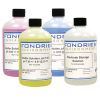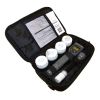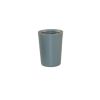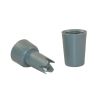YSI EcoSense pH10A pH Pen
Features
- IP-67 Waterproof housing
- Replaceable single- or double-junction electrodes
- Automatic calibration and buffer recognition
- Expedited repair and warranty service
- Lifetime technical support
- More
Overview
YSI's EcoSense pH10A pH & Temperature Pen is the perfect instrument for economical spot sampling of pH and temperature in applications such as wastewater, surface water, aquaculture, hydroponics, pools, and education. The pH10A pen features an easy-to-use graphic interface, simple one-hand operation, memory, and low cost of ownership over the life of the product.
Benefits
- Waterproof IP-67
- 1-year warranty
- Automatic calibration and buffer recognition
- 50-set memory (pH, temp, date and time stamp)
- Replaceable single- or double-junction electrode
- GLP functionality
- 1-, 2-, or 3-point calibration
- Hold feature locks stable readings on the display
- CE compliance
- >200 hour battery life with low battery indicator
- Operating Range: 0.0 to 50.0 C (32.0 to 122.0 F)
- Water Resistance: IP-67 waterproof case
- Weight with Batteries: 105 grams (3.7 ounces)
- ATC Probe: Thermistor
- Battery: Four LR44 alkalines included with purchase
- Battery Life: Approximately 35 hours
- pH Temp Compensation: Auto 0.0 to 99.9 C
- pH Buffer Recognition: USA (4.01, 7.00, & 10.01) or NIST (4.01, 6.86, & 9.18)
- pH Calibration Temp: 0.0 to 60 C (0.0 to 140.0 F)
- pH Offset Recognition: +90 mV at pH 7.00 or +98.3 mV / -81.7 mV at pH 6.86
- pH Slope Recognition: +30% at pH 4.00, 4.01, 9.18, or 10.01
- Memory: Non-volatile; stores 50 sets (pH, temperature, date and time stamp)
- (1) EcoSense pH10A pH & Temperature Pen
- (4) A76 batteries
- (1) Operations manual
In The News
Ocean acidification: University of Washington's giant plastic bags help control research conditions
With oceans becoming more acidic worldwide, scientists are getting creative in designing experiments to study them. For example, one group at the University of Washington is using giant plastic bags to study ocean acidification. Each bag holds about 3,000 liters of seawater and sits in a cylinder-like cage for stability. The group at UW, made up of professors and students, is controlling carbon dioxide levels in the bags over a nearly three-week period, during which they are looking at the effects of increased acidity on organisms living near the San Juan Islands. “These mesocosms are a way to do a traditional experiment you might do in a lab or classroom,” said Jim Murray, professor of oceanography at the University of Washington.
Read MoreNOAA Alaska buoy network to monitor North Pacific ocean acidification
National Oceanic and Atmospheric Administration scientists detected signs of ocean acidification in the waters that hold the vulnerable and valuable fisheries of the North Pacific off the coast of Alaska, but they only had a snapshot of the action. “We know that in this place were important commercial and subsistence fisheries that could be at risk from ocean acidification,” said Jeremy Mathis, a NOAA Pacific Marine Environmental Laboratory researcher and professor at the University of Alaska Fairbanks. To understand how ocean acidification affects the North Pacific, NOAA scientists created a mooring network that collects constant in situ data on parameters contributing to acidification. They hope it will reveal seasonal trends and patterns left out by their snapshots.
Read MoreFrom Hurricanes to Florida’s Red Tides: Monitoring the Southwest Gulf Coast
Nearly every year, southwest Florida is blighted by harmful Karenia brevis blooms–known colloquially as Florida red tides. These harmful algal blooms (HABs) form over the West Florida shelf and are pushed shorewards by winds and currents. Once in touching distance of the coast, they often intensify, fed by land-based runoff, anthropogenic nutrients, and decomposing marine life killed by toxins produced by these red tides. Red tides have become more severe and persistent over the past 20 years, causing major environmental and economic damage.
Read More

















